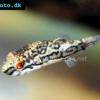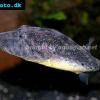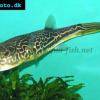Figure eight puffer - Tetraodon biocellatus
Scientific name: Tetraodon biocellatus
Common name: Figure eight puffer
Family: Tetraodontidae
Usual size in fish tanks: 6 - 9 cm (2.36 - 3.54 inch)
014
Recommended pH range: 6.5 - 8
Recommended water hardness: 7 - 16°N (125 - 285.71ppm)
0°C 32°F30°C 86°F
Recommended temperature range: 22 - 27 °C (71.6 - 80.6°F)
The way how these fish reproduce: Spawning
Where the species comes from: South Asia
Temperament to its own species: peaceful
Temperament toward other fish species: aggressive to smaller
Usual place in the tank: Middle levels
Food and Feeding
The Figure-Eight Puffer (Tetraodon biocellatus) is a carnivorous species that requires a protein-rich diet. They should be fed a variety of meaty foods such as brine shrimp, bloodworms, snails, and small crustaceans. Hard-shelled foods like clams or shell-on shrimp are especially beneficial for maintaining their ever-growing teeth. While they may occasionally nibble on plant material, their primary focus is animal-based food. Avoid overfeeding to prevent obesity and ensure good water quality. Feed them 2-3 times a day in small portions.
Origin
The Figure-Eight Puffer is native to Southeast Asia, where it inhabits slow-moving rivers, mangroves, and estuaries in countries such as Thailand, Indonesia, Malaysia, and the Philippines. These habitats are typically brackish, featuring soft substrates, dense vegetation, and ample hiding spots. In captivity, replicating these conditions with slightly brackish water helps ensure their health and comfort.
Tank Setup
Figure-Eight Puffers thrive in a brackish environment. Maintain a specific gravity (SG) of 1.005 to 1.015 to mimic their natural habitat. The tank should include sandy substrates and decorations such as rocks, driftwood, and caves for hiding. Live plants like Java Fern or Anubias can survive in brackish conditions and provide shaded areas. Optimal water parameters include a pH of 6.5-8, hardness of 7-16°N (125-285.71 ppm), and a temperature of 22-27°C (71.6-80.6°F). Strong filtration and regular water changes are crucial to maintain water quality, as puffers are messy eaters.
Temperament
Figure-Eight Puffers are curious and intelligent fish but can exhibit semi-aggressive and territorial behavior. While they may tolerate tankmates in larger setups, they are best kept singly or in a species-only tank. Their temperament toward other fish includes fin nipping or harassment of smaller or slower-moving tankmates. Provide ample space and visual barriers to minimize aggression. Avoid keeping them with long-finned or delicate species.
Sexing
There are no visible differences between males and females, making sexing Tetraodon biocellatus challenging. Behavioral cues during breeding may help distinguish sexes.
Breeding
Breeding Figure-Eight Puffers in captivity is rare but not impossible. The male creates a small depression or selects a flat surface, such as plant leaves or rocks, for egg deposition. After the female lays the eggs, the male guards and fans them to ensure proper oxygenation. The eggs typically hatch within 5-7 days. Raising the fry is challenging due to their tiny size, and they require live foods like rotifers or infusoria during their initial growth stages. Maintaining pristine water conditions and reducing stress is essential for breeding success.
Lifespan
With proper care, the Figure-Eight Puffer can live up to 5 years in captivity. A brackish environment, a varied diet, and stress-free surroundings are crucial for their longevity.
Short Description
The Figure-Eight Puffer (Tetraodon biocellatus) is a fascinating, semi-aggressive species native to Southeast Asia. Known for its unique patterns and engaging behavior, it thrives in brackish aquariums with sandy substrates, hiding spots, and stable water parameters. While they are demanding in terms of care and tank maintenance, their intelligence and interactive nature make them a rewarding choice for experienced aquarists.
Pictures
Bought by aqua-fish.net from jjphoto.dk






 Red
Red  Striped
Striped  Malabar
Malabar  Amazon
Amazon  Red-spot
Red-spot  Bailey’s
Bailey’s  Thai
Thai  Fang’s
Fang’s  Green
Green  Coral
Coral  Giant
Giant  Congo
Congo  Green
Green  Humpback
Humpback  Mekong
Mekong  Bronze
Bronze